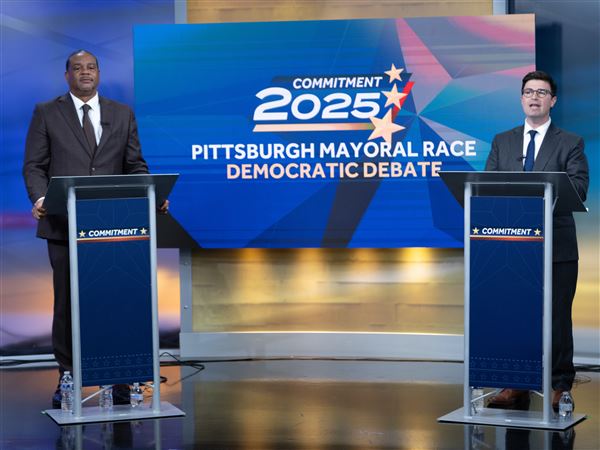Washington, D.C., has the most famous one. Baltimore has one, as do Indianapolis; Buffalo; Cincinnati and Columbus, Ohio; Nashville, Tenn.; Louisville, Ky.; and several other major and midsized cities.
Pittsburgh doesn't have a beltway, and something that bears a slight resemblance to one is years, if not decades, away.
One of the side effects of going belt-less — we don't count the color-coded and mostly ignored Allegheny County belt route system — is that many suburb-to-suburb trips pass through the congested confluence of highways in Pittsburgh's Golden Triangle.
That means backups and delays can loom at virtually any hour in the cramped area where the Parkway East, Parkway West, Parkway North, Route 28 and Route 65 converge, especially at rush hour.
The Pennsylvania Department of Transportation has not studied how much of the traffic in that area is made up of people passing through, rather than bound for, Downtown Pittsburgh, said traffic engineer Todd Kravits.
"It's kind of hard to speculate what life would be like in the Greater Pittsburgh area if we had a beltway," he said.
Development of a real beltway has been discussed at times since the advent of the interstate highway system but nothing serious has materialized, nor is there any looming likelihood, given the enormous costs, disruption and dislocation such a project would carry.
"You'd always be better off if you had easier and more efficient access," Allegheny County Executive Rich Fitzgerald said. Improving transit, including better access to the busways and Light Rail Transit and development of a Bus Rapid Transit corridor, is a bigger priority for relieving congestion, he said, and a beltway likely would not be worth the expense.
Instead the region pursues a partial beltway, the Southern Beltway, which eventually could be part of a tolled bypass from Monroeville to Pittsburgh International Airport. The Pennsylvania Turnpike is moving ahead with the $550 million section from the end of the Findlay Connector to Interstate 79 in northern Washington County, a piece that is expected to take at least five years to build.
It's anybody's guess when, or whether, the remaining unbuilt sections from I-79 to the Mon-Fayette Expressway to the Parkway East, will move ahead.
Some experts say Pittsburgh is better off without a beltway.
"It pulls investment out of the core. It dilutes investment," said Chris Sandvig, regional policy director for the Pittsburgh Community Reinvestment Group. "We haven't really seen a job erosion from the urban core, even when steel went away," he said. The lack of a beltway "is a big part of that."
While Pittsburgh's population has decreased from about 677,000 in 1950 to just over 300,000 today, the number of jobs in the city has held steady at around 300,000, noted Ken Zapinski, senior vice president for energy and infrastructure for the Allegheny Conference on Community Development.
"Pittsburgh as a job center has been incredibly resilient; that's a direct result of not having a beltway," he said. "Beltways elsewhere have shifted the economic center of gravity out from the core."
"There's no doubt that beltways affect land use patterns," said Mark Magalotti, co-director of the University of Pittsburgh's Center For Sustainable Transportation Infrastructure. "One of the major advantages of not having a beltway is that our Downtown has remained viable. I really think it's been an advantage to Pittsburgh in a way because it's kept all of the major employers in Downtown Pittsburgh."
Mr. Sandvig said he has heard stories of employers eyeing a move to the suburbs, only to have a rebellion from workers who lived on the other side of town from the proposed location.
In a city with a beltway, the operations centers of PNC and BNY Mellon likely would have been built in the suburbs, Mr. Zapinski said. Here, the ideal location was Downtown because many workers commute via transit, and most routes serve the Golden Triangle.
The Pennsylvania Turnpike and I-79 are highways that serve the main purpose of a beltway — giving through traffic a way to bypass the center city, Mr. Zapinski said.
It could even be argued that those highways and I-70 form a sort of beltway, albeit one that is much farther out from the city than a typical beltway.
Mr. Magalotti said there's no doubt that Pittsburgh's highway configuration funneling suburban traffic through the Golden Triangle contributes to congestion.
"People who commute from one suburb to another suburb really have no choice. Lots of cities have fairly good arterial systems. We don't really have that. The parkways in Pittsburgh are like local roads as well. You don't have a lot of choices," he said.
The county color-coded belt system might be helpful to people who aren't familiar with local roads but it is mostly irrelevant, he said. "I'm not sure why the county even maintains the signs for it."
Mr. Kravits said Pittsburgh's highway network was built to match its geography. "Going back to the time when roadways were built, they were built along waterways ... our transportation systems followed very closely to the river valleys."
"Given the terrain, Downtown is the location that's most convenient for people all over the region to get to," Mr. Zapinski said. "Getting from one non-Downtown destination to another is difficult to do around here, but I don't think it has anything to do with the lack of a beltway."
"Instead of us thinking that we need a beltway because other cities have beltways, we should be asking ourselves what do we do to nurture development that already exists," Mr. Sandvig said. "If we're going to be successful as a city, we need a balanced approach that emphasizes transportation choices."
— Jon Schmitz: jschmitz@post-gazette.com or 412-263-1868.
First Published: May 13, 2014, 3:26 p.m.
Updated: May 15, 2014, 4:20 a.m.

















